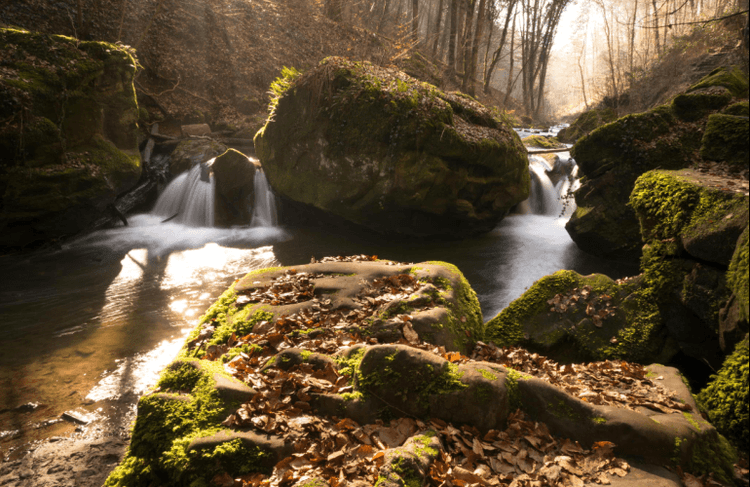
Must-see tourist attractions in Luxembourg
Are you looking for must-visit spots in Luxembourg? Look no further! This captivating Grand Duchy has much to offer, from majestic castles to stunning landscapes. In this article, we will explore 10 unmissable attractions in this small yet magnificent destination.
One of the great advantages of travelling in Luxembourg is the free public transportation. You can travel from one end of the country to the other without spending a single cent on transport.
What are the most popular tourist places in Luxembourg
Luxembourg is a treasure trove of attractions, offering a diverse range of sights and experiences that cater to all types of travellers. If you love castles, there are about 50 (!) to visit in the Grand Duchy, if you are more of a nature lover, there are also unmissable paradises, and if you are a city lover, the capital itself has entire districts listed as UNESCO World Heritage Sites. Luxembourg has a little bit of everything for everyone.
Luxembourg's culture and traditions

Luxembourg's attractions can be broadly categorised to help you plan your visit more efficiently. Here are some of the key types of attractions you can explore in Luxembourg.







Top 10 places to visit in Luxembourg
With so many things to see in Luxembourg, where should you start? We've compiled a list of the top 10 must-visit places that should be at the top of your itinerary. From historic sites to natural wonders, these attractions showcase the best of what Luxembourg has to offer.
Vianden Castle
Opening hours: the Vianden Castle is open daily from 10:00 and closing times depend on the season.
Constructed between the 11th and 14th centuries on the foundations of a Roman castellum and a Carolingian refuge, the castle served as the residence of the counts and dukes of Vianden until the late 15th century. At that time, it was inherited by the House of Nassau and, a century later, passed to the French House of Orange.
In the early 19th century, under the reign of William I of Orange-Nassau, King of the Netherlands and Grand Duke of Luxembourg, the castle was sold and gradually dismantled, leaving it in ruins by 1820.
In 1890, the castle became the property of Grand Duke Adolphe of the Nassau dynasty and remained with the grand ducal family until 1977, when it was transferred to the Luxembourg state. Since then, it has been carefully renovated and restored to its historical splendor, earning its status as a European monument.
Beyond its historical significance, Vianden Castle is famous for its lively medieval festivals. You will be able to enjoy medieval music concerts, sword fights, musket firing displays, bird taming shows, fire-eaters, jugglers, poets, flag bearers, dancers, children's workshops, and a medieval market offering a variety of traditional delicacies.
Casemates du Bock
Closed on 25 December and 1 January
The Luxembourg casemates are full of mysteries. If they could speak, they would tell grim tales from the times when Luxembourg was one of the most coveted fortresses in Europe. The defense system spanned multiple levels, with galleries dug up to 40 meters deep. Due to these formidable bastions, Luxembourg City was aptly nicknamed the "Gibraltar of the North."
In 1867, the fortress was evacuated and had to be dismantled following the neutralization of Luxembourg. The dismantling took 16 years, and the casemates were reduced to 17 kilometers. However, due to their underground location within the city, the network was never completely destroyed.
When the casemates lost their military use, they were repurposed in various ways. During both World Wars, the Casemates du Bock and those in the Pétrusse Valley served as shelters, capable of protecting 35,000 people during air raids or bombings. In 1994, the Bock Casemates were designated a UNESCO World Heritage Site and are now open to the public.
Luxembourg City History Museum
Visitors can explore Luxembourg's development from a medieval fortress to a modern capital, with exhibits covering urban planning, daily life, and significant historical events. Highlights include the impressive glass elevator offering panoramic views and the ancient cellars dating back to the 17th century.
Ville Haute
The picturesque Grund district, nestled in a valley, offers charming streets, traditional houses, and stunning views of the Alzette River. The Notre Dame Cathedral, with its striking Gothic architecture, beautiful stained-glass windows, and serene interior, is a must-visit for history and architecture enthusiasts.
Other notable sites include the Place Guillaume II, a bustling square with markets and events, and the Bock Promontory, offering panoramic views and access to the historic Casemates du Bock.
Read article
Grand Ducal Palace
The site of the current palace originally housed the first town hall of the capital, dating back to 1418. After being destroyed by a gunpowder explosion in 1554, it was rebuilt twenty years later.
In the mid-18th century, a Baroque-style extension was added to the right side, serving as a "public weighing house." In 1860, the Chamber of Deputies was constructed to the right of the palace. Since 1890, the main building has served as the Grand Ducal Palace, and from 1992 to 1995, the palace underwent significant restoration work.
In case you are hesitating to go when you see the ticket price, there is a detail that may interest you. Through the sale of tickets, the Luxembourg Tourist Office supports the "Fondation du Grand-Duc et de la Grande-Duchesse", which funds humanitarian programs and social initiatives aiding vulnerable individuals in Luxembourg and developing countries.
Mullerthal Region
Hiking is one of the main attractions in Mullerthal, with the Mullerthal Trail being a highlight. This 112-kilometer trail is divided into three main routes, each offering a diverse range of scenery, from dense forests and rugged rock formations to serene rivers and charming villages. The trail is well-marked and suitable for both novice and experienced hikers.
In addition to hiking, the region is home to several notable attractions. The Schiessentümpel Waterfall, with its iconic stone bridge, is a must-see. The Hohllay Cave, a former millstone quarry, offers a fascinating glimpse into the region's geological history. In addition, cycling enthusiasts can explore the region's extensive network of bike paths.
Moselle Wine Region
When visiting this region, you can explore charming wine villages such as Remich, Grevenmacher and Schengen, and be sure to visit the local wineries. Wine tastings and winery tours are popular activities where you can learn about the winemaking process and taste the specialties of the region.
The region also offers opportunities for leisurely walks or bike rides along the river, providing stunning views of the vineyard-covered hillsides and the tranquil Moselle waters.
Echternach Abbey
Today, the abbey is renowned for its annual dancing procession held every Tuesday after Pentecost. This traditional ceremony draws tens of thousands of tourists, hikers, pilgrims, and clergy to Echternach, who come to witness or participate in this unique event.
Adjacent to the abbey, the Abbey Museum offers insights into Echternach's history, showcasing a Roman villa, facsimiles of manuscripts produced in the abbey's scriptorium, the life and worship of Saint Willibrord, and archaeological remains. Echternach Abbey stands as a testament to Luxembourg's religious heritage and cultural significance.
National Museum of Military History
With over 100,000 artifacts, it boasts the largest collection of military objects in the region, organized into thematic rooms. Lifelike dioramas at a 1:1 scale depict realistic scenes of soldiers' lives during wartime. Another section of the museum delves into the history of the Luxembourg Army from the establishment of the Grand Duchy to the present day.
Le Chemin de la Corniche
This promenade, often referred to as "the most beautiful balcony in Europe," winds along the old city walls, providing breathtaking vistas of the Lower Town. Lined with charming cafés and historic buildings, it's a must-visit offering a glimpse into Luxembourg's rich architectural and natural beauty.
Schuebefouer
The Schueberfouer offers an exciting array of attractions, including thrilling rides, games, and numerous food stalls serving traditional Luxembourgish delicacies like Gromperekichelcher (potato pancakes) and Mettwurscht (Luxembourgish sausage).
With its vibrant atmosphere, the fair draws visitors of all ages who come to enjoy the festive spirit, live entertainment, and unique market stalls. It's a special event that combines tradition and modernity, making it a highlight of Luxembourg's cultural calendar and a must-visit for anyone looking to experience the country's local charm and excitement.
Frequently Asked Questions (FAQ)
What transportation options are available for getting around Luxembourg?
Are there any local foods I should try while visiting Luxembourg?
When is the best time to visit the Grand Ducal Palace?
Source: castle-vianden.lu, www.luxembourg-city.com, www.mnhn.lu, www.luxembourg-city.com, www.visitluxembourg.com, citymuseum.lu, monarchie.lu, www.researchluxembourg.org, luxembourg.public.lu, www.mullerthal-trail.lu, fr.wikipedia.org, www.visitluxembourg.com, fr.wikipedia.org, diekirch.lu, www.mnhm.net, fr.wikipedia.org, www.luxembourg-city.com, www.visitluxembourg.com
We took photos from these sources: castle-vianden.lu, luxembourg-city.com, Ville de Luxembourg, visitluxembourg.com, Unsplash, Wikipedia, monarchie.lu, researchluxembourg.org, mullerthal-trail.lu, moselweine.shop, diekirch.lu, luxembourg-city, John Oesch for Luxtimes
































